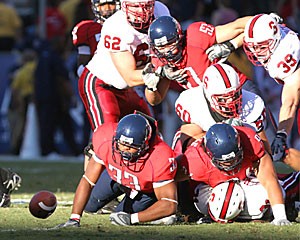Oh, what a predicament the Arizona football team finds itself in.
After winning six games in 2006, the Wildcats knew if they wanted an invitation to partake in the postseason this year they needed to win seven games.
After losing to foes such as New Mexico and Stanford – something that should be inexcusable – getting to that plateau is officially impossible.
Luckily for the Wildcats, they have two opponents in the top five in the Bowl Championship Series rankings still remaining on their schedule, and their chances of a postseason remain in reach – if you have faith.
Losing isn’t an option. Though there isn’t a playoff situation in the BCS, a playoff situation is exactly what Arizona is facing.
It is undoubtedly an extremely difficult road, but this year it’s been apparent in college football that anything can happen (see Appalachian State over Michigan on the road).
If the Wildcats want to have a chance, they must do these three things to get through the next three weeks with a smile on their faces:
Stay loose
After their most recent loss to Stanford on Oct. 20, it seemed the Wildcats had nothing left to play for.
There was no “”next week.”” It didn’t matter if they won or lost.
Though that sounds like the worst-case scenario for a team, it worked in Arizona’s favor last weekend. Offensive coordinator Sonny Dykes said his team “”played without the fear of making mistakes”” in a 48-41 comeback victory at Washington.
“”Guys had chances to make plays on the ball, and they made them, and that is what I think most of these games come down to,”” he said. “”Finding ways to win the game and fighting adversity.””
Players said Arizona head coach Mike Stoops told them before kickoff in Seattle that one play cannot determine the outcome of the game, and to shrug off any mistakes they make.
“”He said if you make a mistake, it is just one play,”” said safety Michael Klyce.
Washington was just one win, however, and in the coming weeks, especially if they continue to be victorious, the players may begin to feel the pressure they had previously shed. It is important for players to remain loose, play the game for fun and focus on one play at a time.
“”As far as worrying about a bowl game and all of that, we still have a long way to go,”” Dykes said. “”We need to beat UCLA (on Saturday) before any of that becomes relevant.””
Take chances
Fans have complained often this season about Arizona frequently throwing short, especially in the flats. If there was one thing different about the Washington win, it was quarterback Willie Tuitama’s ability to take shots downfield.
Though many people have been pointing the finger at Stoops – who doesn’t call the plays – for the predictability of the Wildcats’ playcalling, Tuitama does have check-downs and hasn’t had the all the time in the world in the pocket lately.
When the Wildcats take shots downfield, you see the results: big plays, large yard totals and an abundance of points scored. With the Wildcats in the position they are in, there is no more need for a conservative approach on offense.
Maybe it’s time to toss out a few trick plays – even if they don’t work, they still keep the defense honest – or maybe give Mike Thomas the ball on a few rushing plays. After all, the 5-foot-10 wide receiver is the team’s second-leading runner in terms of yards.
High-scoring foes Oregon and ASU linger in the Wildcats’ future. Arizona’s should-be approach is simple: throw it up.
Don’t abandon the run game
Sure, I just said “”throw it up,”” but Arizona still can’t afford to abandon the run.
So far this season, most of the Wildcats’ success has stemmed from a balanced attack that embraces an effective ground game.
Arizona is 1-5 when rushing for fewer than 100 total yards. In most of those games games, the Wildcats failed to rush for half that mark.
Arizona rushed for only 32 yards in a season-opening loss to BYU. In subsequent losses to New Mexico and then-No. 6 California, it rushed for 38 and 21, respectively.
With a promising young running back like freshman Nic Grigsby in the mix, it is important to incorporate him, even if he runs just to open up the pass.
Why it can happen
Based on the premise of Arizona winning its final three games, this article could draw disbelief or even laughter. But looking at the remaining schedule and Arizona’s November past under Stoops, it doesn’t seem that unlikely the Wildcats could turn some heads.
Let’s start with Saturday’s Homecoming game. The Wildcats have orchestrated major upsets the last two years on Homecoming, including a 52-14 spanking of then-No. 7 UCLA and last year’s 24-20 victory over then-No.8 California.
Next is that unexpected victory over a ranked opponent that has Arizona fans wishing the team could perform like that every game.
Though it has come on Homecoming in recent years, this year’s candidate is Oregon at home on a Thursday night (Nov. 15) on ESPN.
After beating the Golden Bears last season, the Wildcats creamed Oregon 37-10 at Autzen Stadium – breaking a 20-year road losing streak against the Ducks. Even though Oregon has appeared unstoppable of late, the Wildcats may be able to tap into confidence from last year’s blowout and pull an epic upset.
And then comes the ASU gameð – for the Territorial Cup.
Like most other rivalry games, anything can happen. Three years ago, A 2-8 Arizona team defeated a 8-2 Sun Devils squad in Tempe, and the teams’ records may not be all that different next month.
If the Wildcats don’t lose leading into that game, it should be even more interesting. Arizona surely wants to become bowl-eligible against the team that ruined its postseason hopes at Arizona Stadium last season.
Ari Wasserman is a journalism junior. He can be reached at sports@wildcat.arizona.edu.









